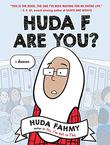Tears, fears, and a whole lot of humor bubble up in comics artist Huda Fahmy’s Huda F Are You? (Dial Books, Nov. 23), a graphic novel/memoir hybrid for young adults. Hard truths about life as a visibly Muslim woman in America are a mainstay of Fahmy’s work, as seen in her debut, Yes, I’m Hot in This, and in witty webcomics. Here, she depicts a fictionalized teenage version of herself who gropes awkwardly for a sense of self-identity beyond the hijab she wears, with plenty of comedic missteps along the way. Our review calls the book “hilarious, charming, and much needed” for its adept, heartfelt handling of themes like xenophobia, teenage self-loathing, and finding validation. Fahmy, who lives in Houston, Texas, answered our questions about the book via email. The interview has been edited for length and clarity.
After writing for adults, how did you tailor Huda F Are You? to young adult readers, especially when it came to handling themes like Islamophobia and racism?
It was a matter of putting myself in my old high school shoes. I’d be lying if I said it wasn’t difficult every time I went there. I was a sophomore in high school when 9/11 happened, so it’s not a time that I enjoy revisiting. Islamophobia and racism don’t care what age you are, and even the youngest among us find themselves victim to it. It becomes a responsibility, then, to help young readers try to navigate these harsh realities and come out stronger despite them. Also, I’d be remiss not to credit my amazing editors at Dial for helping me keep the tone age-appropriate.
Why was it important to you to reach younger readers?
Can I be selfish and say I wrote this book for me? It is the book I wish I had growing up struggling with my Muslim, Arab, American identities. I want young readers to benefit because the struggle with identity is so universal and so looming at this age. I hope that hearing there’s no right or wrong way to figuring out who you are helps relieve the stress and anxiety that often plague young readers.
How did you decide to bring a fictional element into this book, as opposed to making the book a strictly nonfiction graphic memoir?
 Short answer: I wanted more freedom. I didn’t want to be limited to just my life when it came to telling this story of identity and self-discovery.
Short answer: I wanted more freedom. I didn’t want to be limited to just my life when it came to telling this story of identity and self-discovery.
Long answer: 9/11 was a major event that shaped my high school life and the years after. I realized that young readers today might not fully grasp the trauma that many [prople of color] experienced because of the events of this tragic day. Instances of Islamophobia and racism are unfortunately as present today as they ever were, so that gave me much more freedom in telling a story that isn’t just based on my life and experiences, but on the experiences of young people of color who experience micro- and macroaggressions daily.
What were some of the comics that you loved when you were growing up? How about now?
“Garfield,” “Calvin and Hobbes,” “The Far Side,” different manga series. I still enjoy “Calvin and Hobbes” and “The Far Side.” I love graphic novels by Gene Luen Yang, Raina Telgemeier, and Svetlana Chmakova and web comics by amazing artists like Weinye Chen (It’s Weinye), Marzi Williams (Introvert Doodles), and Asbah Alaena (AMuslimMama). I wish I could list them all.
Amid all the humor, how did you find the emotional inflection points in this story, especially Huda’s moving relationship with her mother?
When my mother read those scenes for the first time, she cried. In the book, Huda’s relationship with her mother, as seen in these poignant moments, is an essential plot device that drives Huda to self-discovery. Huda’s mother wants her kids to be stronger than she was. [In the past,] she let shame and fear stop her from living her life the way she wanted, and she regrets it. She decides to become an example of strength for her kids. It’s something Huda admires but fears she can never live up to.
Why did you want to examine Huda’s family’s shift away from cultural assimilation?
As a kid, I felt a strong push to assimilate, so common among immigrants and first-generation Americans. The fear of violence and backlash against us, simply for being Arab and Muslim, was so real. All I wanted to do was survive. I did that by trying to fit in.
As I got older, that fear turned into anger and indignation. Why should I be afraid to be myself? Why should I be ashamed to proudly display my culture, beliefs, and heritage? This change of perspective spoke so much to Huda’s shift in understanding identity and taking pride in her religion and culture. I feel a lot of young readers, similarly, want to fit in but are afraid it means they’ll have to give up a lot of what defines their identity.
Are more YA or kid lit books in your future?
Yes! I’m working on another YA graphic novel, and I would love to venture into children’s literature someday soon.
Hannah Bae is a Korean American writer, journalist, and illustrator and winner of a Rona Jaffe Foundation Writer’s Award.



































